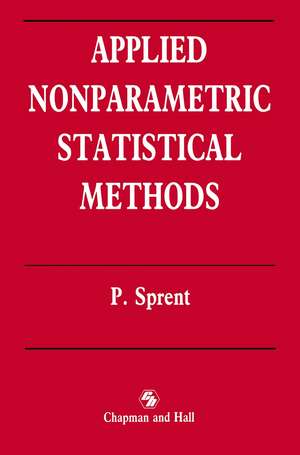Applied Nonparametric Statistical Methods
Autor Peter Sprenten Limba Engleză Paperback – 26 sep 2011
Preț: 386.81 lei
Nou
Puncte Express: 580
Preț estimativ în valută:
74.02€ • 79.15$ • 61.71£
74.02€ • 79.15$ • 61.71£
Carte tipărită la comandă
Livrare economică 18 aprilie-02 mai
Preluare comenzi: 021 569.72.76
Specificații
ISBN-13: 9789401070447
ISBN-10: 940107044X
Pagini: 272
Ilustrații: X, 260 p.
Dimensiuni: 155 x 235 x 14 mm
Greutate: 0.39 kg
Ediția:1989
Editura: SPRINGER NETHERLANDS
Colecția Springer
Locul publicării:Dordrecht, Netherlands
ISBN-10: 940107044X
Pagini: 272
Ilustrații: X, 260 p.
Dimensiuni: 155 x 235 x 14 mm
Greutate: 0.39 kg
Ediția:1989
Editura: SPRINGER NETHERLANDS
Colecția Springer
Locul publicării:Dordrecht, Netherlands
Public țintă
ResearchCuprins
1 Introducing nonparametric methods.- 1.1 Basic statistics.- 1.2 Hypothesis tests.- 1.3 Estimation.- 1.4 Samples and populations.- 1.5 Further reading.- 1.6 Computers and nonparametric methods.- Exercises.- 2 Location estimates for single samples.- 2.1 The sign test.- 2.2 Inferences about medians based on ranks.- 2.3 Other location estimators.- 2.4 Fields of application.- Exercises.- 3 Distribution tests and rank transformations for single samples.- 3.1 Matching samples to distributions.- 3.2 Robustness.- 3.3 Transformations of ranks.- 3.4 Practical implications of efficiency.- 3.5 Modified assumptions.- 3.6 Fields of application.- Exercises.- 4 Methods for paired samples.- 4.1 Comparisons in pairs.- 4.2 A less obvious use of the sign test.- 4.3 Fields of application.- Exercises.- 5 Tests and estimation for two independent samples.- 5.1 Location tests and estimates.- 5.2 Wilcoxon—Mann—Whitney confidence intervals.- 5.3 Tests on functions of ranks.- 5.4 Tests for equality of variance.- 5.5 A test for a common distribution.- 5.6 Fields of application.- Exercises.- 6 Three or more samples.- 6.1 Possible extensions.- 6.2 Location tests for independent samples.- 6.3 Tests for heterogeneity of variance for independent samples.- 6.4 Further tests for several independent samples.- 6.5 Location comparisons for related samples.- 6.6 Fields of application.- Exercises.- 7 Bivariate and multivariate data.- 7.1 Correlation in bivariate data.- 7.2 Nonparametric bivariate linear regression.- 7.3 Monotonie regression.- 7.4 Multivariate data.- 7.5 Fields of application.- Exercises.- 8 Counts and categories.- 8.1 Categorical data.- 8.2 Tests for independence in two-way tables.- 8.3 The log-linear model.- 8.4 Goodness of fit tests for discrete data.- 8.5 Fields of application.-Exercises.- 9 Robustness, jackknives and bootstraps.- 9.1 The computer and robustness.- 9.2 Jackknives and bootstraps.- 9.3 Fields of application.- Exercises.- 10 Looking ahead.- 10.1 Nonparametric methods in a wider context.- 10.2 Developments from basic techniques.- 10.3 More sophisticated developments.- 10.4 The Bayesian approach.- A1 Random variables.- A2 Permutations and combinations.- A6 Least squares regression.- A7 Data sets.- A8 Tables of critical values for nonparametric methods.- References.- Solutions to odd-numbered exercises.


